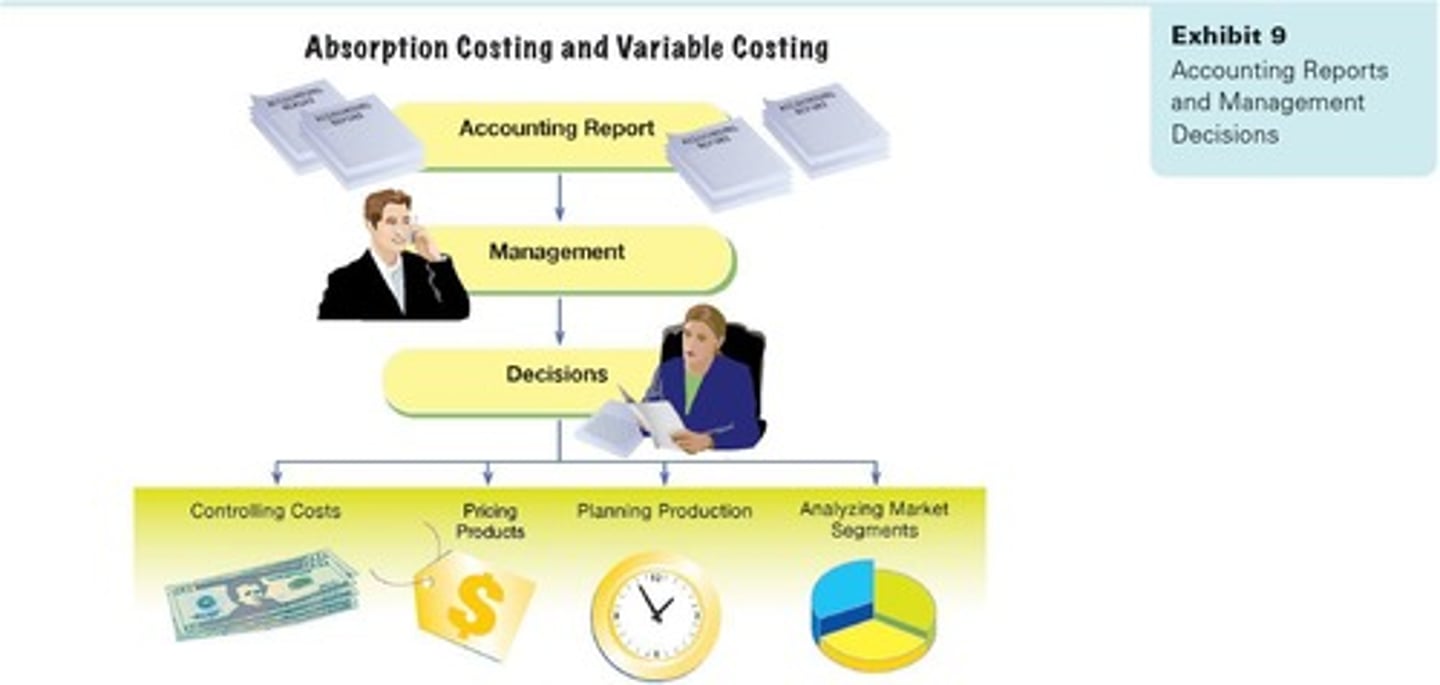Variable Costing for Management Analysis(Chapter 21)
1/77
There's no tags or description
Looks like no tags are added yet.
Name | Mastery | Learn | Test | Matching | Spaced |
|---|
No study sessions yet.
78 Terms
Absorption Costing
Includes fixed and variable factory costs in inventory.
Variable Costing
Includes only variable manufacturing costs in inventory.
Operating Income
Profit calculated after deducting costs from revenue.
Manufacturing Margin
Sales minus variable cost of goods sold.
Contribution Margin
Manufacturing margin minus variable selling and administrative expenses.
Fixed Factory Overhead
Costs not included in variable costing inventory.
Period Expense
Costs treated as expenses in the period incurred.
Units Manufactured
Total number of units produced during a period.
Units Sold
Total number of units sold to customers.
Inventory Change
Affects operating income under different costing methods.
EBITDA
Earnings before interest, taxes, depreciation, and amortization.
Segment Analysis
Evaluating performance by product, territory, or salesperson.
Sales Price
Selling price per unit, e.g., $50 for Martinez Co.
Direct Materials
Raw materials directly used in manufacturing goods.
Direct Labor
Labor costs directly associated with production.
Variable Selling Expenses
Costs that vary with sales volume.
Operating Income Comparison
Differences between absorption and variable costing methods.

Cost of Goods Sold
Total cost of manufacturing sold products.
Increase in Inventory
Occurs when units manufactured exceed units sold.
Decrease in Inventory
Occurs when units manufactured are less than sold.
Absorption Costing Income Statement
Financial statement reflecting absorption costing results.

Variable Costing Income Statement
Financial statement reflecting variable costing results.
Operating Income Variance
Difference in income based on inventory levels.
Market Segment Analysis
Evaluating performance across different market segments.
Service Businesses
Businesses that provide services rather than goods.
Cost Structure
Composition of fixed and variable costs in operations.
Units Manufactured
Total units produced during a specific period.
Units Sold
Total units sold to customers in a period.
Fixed Factory Overhead Costs
Costs not variable with production volume.
Variable Costing
Costing method treating fixed overhead as period expense.
Absorption Costing
Costing method including fixed overhead in product costs.
Operating Income
Profit after deducting operating expenses from revenue.
Contribution Margin
Sales revenue minus variable costs.
Period Expenses
Costs incurred regardless of production levels.
Controllable Costs
Costs influenced by management at a specific level.
Noncontrollable Costs
Costs managed by higher levels of management.
Sales Volume
Total quantity of products sold.
Finished Goods Inventory
Completed products ready for sale.
Cost of Goods Manufactured
Total production costs of goods completed.
Pricing Products
Setting prices based on costs and market factors.
Planning Production
Determining production levels based on forecasts.
Analyzing Market Segments
Evaluating performance of different market divisions.
Operating Income Under Variable Costing
Remains constant regardless of production changes.
Inventory Effects on Income
Changes in inventory impact reported income levels.
Management Decisions
Strategic choices based on financial information.
Absorption Costing Income Statement
Financial report showing costs absorbed by products.
Variable Costing Income Statement
Financial report showing only variable costs.
Sales Estimate
Projected sales based on market analysis.
Production Levels
Quantity of units produced in a time frame.
Fixed Manufacturing Costs
Costs that do not change with production volume.
Cost Control
Monitoring and managing costs to improve profitability.
Income Misinterpretation
Incorrect conclusions drawn from income variations.
Inventory Increase Impact
Raising inventory can inflate operating income.
Fixed Costs
Costs that cannot be avoided regardless of production.
Variable Costs
Costs that vary directly with production volume.
Minimum Selling Price
Price covering at least variable costs.
Absorption Costing
Includes fixed and variable costs for long-term analysis.
Variable Costing
Focuses on variable costs for short-term analysis.
Market Segment
A portion of a company analyzed for profitability.
EBITDA Margin
EBITDA expressed as a percentage of sales.
Operating Income
Income from normal business operations.
Depreciation Expense
Reduction in value of assets over time.
Amortization Expense
Gradual write-off of intangible assets.
Sales Territories
Geographical areas assigned for sales activities.
Product Segments
Different product lines analyzed for profitability.
Salespersons Segments
Performance analysis based on individual salespersons.
Public Companies
Companies whose shares are traded publicly.
Segment Disclosures
Financial information about specific business segments.
Strengths and Weaknesses
Analysis of segment performance indicators.
Operating Decisions
Choices made regarding production and sales operations.
Short Run
Period where production capacity is fixed.
Long Run
Period allowing for capacity expansion.
Financial Statements
Reports summarizing financial performance.
Footnote Disclosure
Additional information provided in financial statements.
Camelot Fragrance Company
Example company used for segment analysis.
Amazon Web Services (AWS)
Amazon's cloud computing segment.
Comparative Analysis
Evaluating performance across different segments.
Profitability
Ability to generate profit from operations.